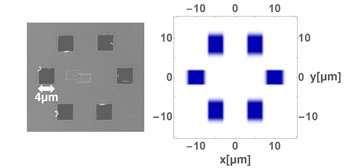Diffused light shows clear structures

Scientists gain an insight into the fascinating world of atoms and molecules using x-ray microscopes. Ground-breaking research by physicists at Friedrich-Alexander-Universität Erlangen-Nürnberg (FAU), the Deutsches Elektronen Synchrotron (DESY) in Hamburg, and the University of Hamburg has paved the way towards new imaging techniques. The team of scientists have successfully developed and tested a method which is considerably more effective than conventional procedures. The researchers' findings have recently been published in Nature Physics.
Conventional methods researchers use to determine the structure of crystals and minerals are based on the coherent scattering of light. In other words, light waves hit a structure and are deflected, but continue to oscillate without their pattern of crests and troughs being distorted or interrupted in any way. If a sufficient number of these photons can be measured with a detector, a characteristic diffraction pattern is obtained which can be used to derive the pattern of scattered atoms or the crystal structure.
Most light waves, however, are scattered incoherently, that is the wave patterns of the outgoing waves are no longer directly in relation to the incoming waves as the light is reflected from the atoms it touches as fluorescent light. The result is diffuse background light which scientists have until now believed was not suitable for imaging, having a negative effect on the accuracy of the method.
This incoherently scattered light, however, is precisely what has now been used to analyse a structure. At DESY, the researchers successfully created an image of a hexagonal, micrometre sized structure in the shape of a benzene ring. The basic technique behind this procedure is not new. Robert Hanbury Brown and Richard Q. Twiss used incoherent light to determine the diameter of stars as early on as 1956. The team of researchers from Erlangen and Hamburg have now refined this method, using it to analyse microscopic structures.
The innovative method has one decisive advantage. 'The smaller the structures to be imaged, the larger the proportion of incoherently scattered light,' explains the lead author of the study, Raimund Schneider from FAU. 'Whilst this poses coherent imaging increasing problems with intensity, our method actually benefits from it.' The new method has the potential to achieve a significant improvement in analysing structures in the fields of biology and medicine.
More information: Raimund Schneider et al, Quantum imaging with incoherently scattered light from a free-electron laser, Nature Physics (2017). DOI: 10.1038/nphys4301
Journal information: Nature Physics
Provided by University of Erlangen-Nuremberg




















